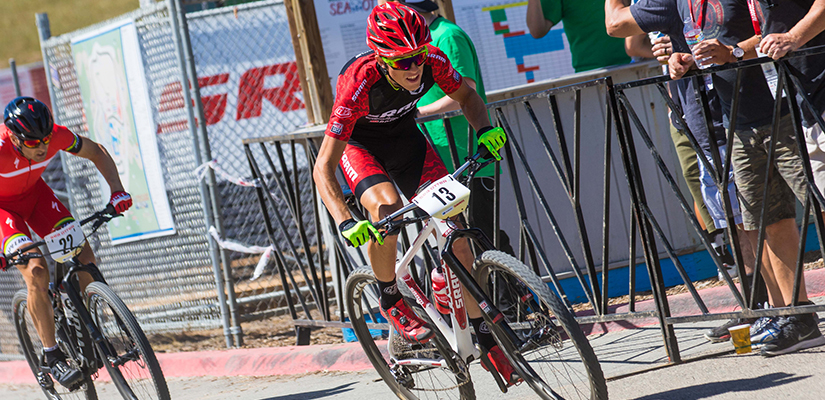Specialty Blocks: Short Track Cross-Country

From a fitness perspective, only minor disparities exist between cyclocross racing and short track XC racing, but there are enough differences between the two to merit individual plans for each. These subtle differences inspired only mildly different plans, but ones that can build on one another really well as you use your STXC training & racing as a brutal and highly effective ramp into your ‘cross season.
Overview
As with most forms of MTB racing, Short Track XC races rely on short, explosive efforts both in the beginning of a race in addition to the potentially hundreds of others to follow. So riders have to be able to generate a lot of power quickly, briefly & repeatedly and also possess the ability to follow these intense efforts with sustained, near-FTP work immediately after – and “near” means below and above FTP.
These often diverse and always intense event characteristics breed the sort of rider who can pretty much do it all while in a redlined state, so specialty blocks for these riders have to cover a lot of fitness bases while keeping a steady emphasis on intensity.
The best way to accommodate so many possible overlaps is to combine interval formats, but it’s also necessary to narrow the training scope and chase specific types of capabilities as well. So these specialty blocks contain workouts devoted solely to maximum aerobic power, devoted solely to intensive efforts just far enough above FTP to promise sustained suffering, as well as workouts combining these efforts and even those that add other demands.
STXC Demands & Training
With short but highly demanding race courses that see riders working hard throughout, any competitive short-track rider has to have a finely tuned aerobic engine, one that can dam up high levels of muscle acidity and then patiently & painfully ride through that burn without losing position on tight singletrack-ish laps.
And clearly there’s an emphasis on the ability to generate high power again & again without cooking the legs to a point where this repetition is no longer sustainable. What’s more, all but that single lead riders is going to dictate the pace leaving everyone else to suffer in his/her wake of superior fitness.
But learning to suffer at someone else’s discretion without falling apart falls right in line with the nature of a structured training plan devised by someone else, someone who calls the shots that you must follow lest you suffer the dissatisfaction of falling off pace or falling short of a workout’s prescription.
But there does exist some leniency in the form of alternate workout versions that offer flexibility and opportunity for personalization should any of the workouts prove too hard or perhaps not hard enough relative to your near-peak fitness.
Specialty Block Structure
Immediately on the heels of your Base/Build conditioning, the first 6 weeks of each volume-version of these specialized STXC blocks seeks to maintain your training momentum by thrusting you right into the intensity. The emphasis here is on just what’s described above: maximum aerobic power in the VO2max range, hard starts well into anaerobic/near-maximal territory & plenty of muscle endurance work in painful proximity to FTP.
The fourth week is the typical rest week where the reduction in training load mirrors the overall volume of the block itself. That is to say, if you’re on a low-volume plan, don’t expect a sizable reduction in training load, but if you’re on a higher-volume version of the STXC specialty block, this recovery week actually looks a bit like recovery.
The same can be said about the final 2 taper weeks where the taper is more pronounced the higher the training volume which precedes it; low-volume trainers see a subtler taper than higher-volume trainers.
The timing of your most important events will influence your target completion date, but there’s nothing to prevent you from taking part in lower-priority races in place of weekend workouts. And should you want to extend this plan to accommodate further weeks of racing, the format of the 2 taper weeks works well for as many additional weeks as you can handle.
Block Progressions
As with any properly periodized MTB training progression, a Short Power Build block is the best-fit build block but the General Build block remains very much in line with the diverse demands of trail racing too.
Prior to these Build blocks, anywhere from 6-12 weeks of Sweet Spot Base training or even 12-16 weeks of Traditional Build conditioning are recommended, especially if your season is a long one and your planning affords months of training prior to your most important events.
Optimally, riders will reach these MTB specialty blocks with sufficient base mileage and properly timed and progressed build conditioning, so here a few training periodization structures based on that assumption:
- 28 Weeks Out: 12 weeks of Sweet Spot base conditioning + 8 weeks of Short Power Build conditioning + 8 weeks of Short Track Cross-Country specialization
- 22 Weeks Out: 6 weeks of Sweet Spot Base II + 8 weeks of the Short Power Build + 8 weeks of Short Track XC specialization
- 14-16 Weeks Out: 6 weeks of Sweet Spot Base II or 8 weeks of Short Power Build + 8 weeks of the STXC specialty block
And as mentioned earlier, the similar demands and seasonal timing of STXC racing & subsequent cyclocross racing make these blocks ideal early-season, race conditioning for ‘cross racers eager to get some highly specific workouts & races under their belts before rebuilding into their Cyclocross specialty blocks.
